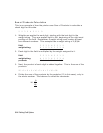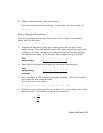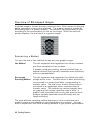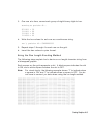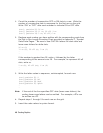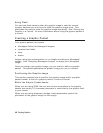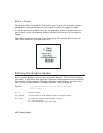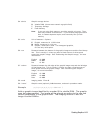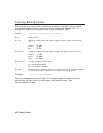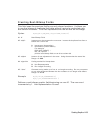1. Count the number of consecutive OFF or ON dots in a row. Write the
number of consecutive dots in sequence for the first row on the grid.
Write “ON” or “OFF” after each number to indicate ON or OFF dots.
(row 1, position 50) 26 on
(row 2, position 39) 11 on, 26 off, 9 on
(row 3, position 34) 5 on, 45 off, 6 on
2. Replace each number you have written with its corresponding code from
the Dot to Run Length Encoding Chart provided in Appendix C, “Symbol
Sets/Code Pages.” Be sure to use CAPITAL letters for black dots and
lower-case letters for white dots.
26 on (Z)
11 on (K), 26 off (z), 9 on (I)
.
.
If the number is greater than 26, write z, followed by the letter
corresponding to the amount over 26. For example, to represent 45 off
dots, write zs.
5 on (E), 45 off (zs), 6 on (F)
.
.
3. Write the letter codes in sequence, uninterrupted, for each row.
(row 1,position 50) Z
(row 2,position 39) KzI
(row 3,position 34) EzsF
(row 4,position 30) DpZoD
.
.
Note: If the end of the line specifies OFF dots (lower-case letters), the
ending lower-case letters can be omitted. For example, uZFu can
be written as uZF.
4. Repeat steps 1 through 5 for each row on the grid.
5. Insert the code values in syntax format.
4-6 Creating Graphics



